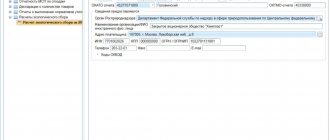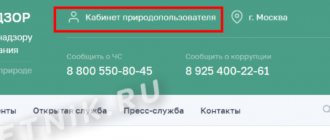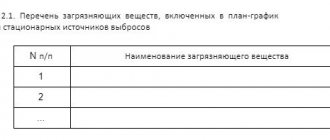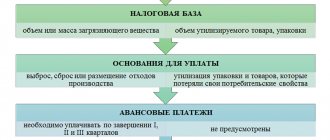Persons obliged to pay a fee for negative environmental impact (NEI), with the exception of small and medium-sized businesses, must pay quarterly advance payments (except for the fourth quarter) no later than the 20th day of the month following the last month of the corresponding quarter. The deadline for paying taxes for the second quarter of 2021 expires on July 20. 1C experts have prepared a review of current materials—regulatory legal acts, letters from Rosprirodnadzor, bills—concerning the rules for calculating and paying fees for NVOS.
Who is the payer of the tax collection fee?
Payers of the fee for negative environmental impact (NEI) are organizations and individual entrepreneurs that emit pollutants into the air through stationary sources, into water bodies or are engaged in the storage and burial (disposal) of waste (clause 1 of article 16, clause 1 Article 16.1 of the Law “On Environmental Protection” dated January 10, 2002 No. 7-FZ).
Decree of the Government of the Russian Federation dated September 18, 2020 No. 1496 contains a complete list of types of activities and other criteria for classifying objects into categories I–IV of environmental impact, in which the organization must pay for the environmental impact assessment. In particular, these include mining, metallurgical, chemical, food production, some agricultural companies, and municipal solid waste landfills.
If business activities are carried out only at category IV facilities, then there is no need to pay a fee for negative impact (Clause 1, Article 16.1 of Law No. 7-FZ).
Category IV includes facilities where:
- there are no releases of radioactive substances;
- there are no discharges of pollutants generated when water is used for industrial needs into sewers and the environment, surface and underground water bodies, as well as onto the earth's surface;
- there are discharges of pollutants resulting from the use of water for domestic needs;
- there are stationary sources of pollutant emissions, and their quantity is no more than 10 tons per year;
- There are only non-stationary sources of pollutant emissions.
Thus, the use of motor transport in business activities does not lead to the need to pay for negative impacts, since payment is made only for stationary objects, to which it (motor transport) does not apply (Clause 1, Article 16 of Law No. 7-FZ).
IMPORTANT! The obligation to pay the fee does not depend on the tax regime applied by organizations or individual entrepreneurs that are payers of the fee for negative impact, as well as on whether activities are carried out at their own or leased facilities that lead to a negative impact on the environment.
Payers of the fee must submit an application to Rosprirodnadzor for each polluting facility and receive a certificate of registration indicating the polluting category from I to IV.
IMPORTANT! If the process of activity generates only production and consumption waste and there are no other negative impacts, then an application for registration under the NVOS is not submitted (letters of Rosprirodnadzor dated 02.21.2017 No. AS-06-02-36/3591, dated 10.31.2016 No. AS -09-00-36/22354). Since when carrying out trading activities and providing services, the functioning of offices, schools, kindergartens, administrative buildings, clinics, hospitals, etc., as a rule, only production and consumption waste is generated, we can conclude that registering with them there is no need to act as a payer of the Taxpayer Tax.
Payment for negative impact on the environment should not be confused with an environmental fee. These are different payments. You can read about the differences here.
Registration procedure
The registration procedure is prescribed in the new Article 69.2 of Federal Law No. 219-FZ. the rules are effective from January 1, 2015.
Within six months from the date of commissioning of the facility, the payer organization is required to register with Rosprirodnadzor. Enterprises that operate on sites before January 1, 2015 must register by 2021. To do this, you need to submit the appropriate application in paper or electronic form with an electronic signature.
Organizations are issued standards for five years. Every year, the organization is required to confirm the immutability of data.
If the payer has any changes, then Rosprirodnadzor must be notified about this within 30 days.
What changes must be notified about:
- Replacement or transformation of the organization;
- Change of details (name, address, etc.)
- Changing the place of registration of the object;
- Changes in technology affecting the types and volumes of emissions (discharges, waste);
- Changes in disposal of emissions or waste.
If the organization ceases to operate at the facility, then it is necessary to submit an act of liquidation or conservation of the facility. In this case, the organization is deregistered and no payment is made.
Organizations working at facilities of groups 1, 2 and 3 from January 1, 2015 are required to draw up an environmental control program. Based on the results of the reporting period, Rosprirodnadzor submits information about appointed persons for control, about the activities carried out and about the results of control.
Data on which fee calculation is based
Calculation of fees for negative impact on the environment (or fees for pollution) depends on many factors:
- nature of the source of pollution;
- type of pollutant (or its hazard class);
- volumes of actual emissions;
- the fact that there are no means of measuring emissions;
- presence of excess pollution above established standards;
- the fact that the contaminated object or territory is under special protection;
- expenses incurred on measures to reduce negative impacts.
Based on the first 2 indicators, the rate used in the calculation is determined. By multiplying it by the volume of actual emissions (if it does not exceed the maximum permissible) the amount of payment for pollution is determined. The following odds are applied to the bet amount:
- increasing, if we are talking about the lack of means of measuring emissions, exceeding permissible pollution standards, or the location of an object (territory) under special protection;
- reducing, depending on the hazard class of the disposed waste, the method of its generation and disposal.
The maximum multiplying factor (120) may arise in a situation where there are no means to measure volumes. Exceeding the standards leads to the application of coefficients equal to 5 (if the excess occurs during the period of planned reduction of discharges) or 25. For an object (territory) under special protection, a coefficient of 2 applies.
The specific size of the reduction factor can be determined by a combination of factors influencing it and range from 0 to 0.67.
The presence of expenses for measures to reduce negative impacts allows you to reduce the amount of accrued fees.
Also, the amount of amounts payable at the end of the year is influenced by the fact that advances on pollution payments were transferred during the year.
How to calculate taxes for those who do not recycle?
The total amount of environmental tax in 2021 is calculated separately for all types of goods that require disposal. The formula will be like this:
Sometimes the mass of the finished product is substituted into the formula, and sometimes the number of units for which disposal is required.
Recycling standards, together with environmental tax rates, will help you understand which indicator should be used for a particular type of product.
back to menu ↑
Rates applied for calculation for 2021
The rates used to calculate pollution charges are established by Decree of the Government of the Russian Federation dated September 13, 2016 No. 913 (as amended on January 24, 2020). It shows rates for 2016-2018. And in 2021, the rates of 2021 are applied with a coefficient of 1.08 (Resolution of the Government of the Russian Federation dated September 11, 2020 No. 1393).
ConsultantPlus experts explained how to calculate the fee for the NVOS at the end of the year. To do everything correctly, get trial access to the system and go to the Ready solution. It's free.
Depending on the type of polluting object, they are divided into 3 groups related to objects:
- stationary, producing emissions into the atmosphere;
- those carrying out discharges into water bodies;
- producing production and consumption waste.
For the first 2 groups, specific rates are indicated in relation to each of the names of the pollutant. For waste, the rate is tied to a specific hazard class.
In order to encourage legal entities and individual entrepreneurs to take measures to reduce the negative impact on the environment and introduce the best available technologies, when calculating fees for environmental assessments, the coefficients specified in paragraphs are applied to the rates of such fees. 5 (from 2020) and 6 tbsp. 16.3 of Law No. 7-FZ.
Harmful effects on the environment, species
The following actions have a negative impact on nature:
- Emissions of harmful substances into the atmosphere by stationary objects (pipes of factories, boiler houses, diesel installations, cutting and welding of metals, etc.);
- Waste disposal;
- Pollution of water resources by discharges;
- Harm to the soil and subsoil of the earth.
For more information about payments and environmental fees, read the article: → Payments for the use of natural resources and their features.
Reporting form and deadlines for submission
The entire procedure for calculating pollution fees is reflected in the declaration, issued once a year, upon its completion. For 2020, this report is compiled according to the form approved by Order of the Ministry of Natural Resources of Russia dated December 10, 2020 No. 1043 (Appendix No. 2).
The declaration consists of:
- from the title page reflecting information about the reporting entity;
- section in which the final calculated amounts of payments generated by sections are combined into a single amount, which is successively adjusted to the values to be paid or returned to the payer by taking into account the costs of measures to reduce the negative impact and advances paid;
- three sections, separated by the main types of pollution sources, in which, in fact, the calculation of payments for each source is carried out.
The tables of sections intended for calculation provide for the reflection in them of all the data necessary for calculating the amount of the board:
- permissible and actual volumes with the allocation of excess amounts;
- rates;
- applied coefficients;
- components of the calculated amount of the fee and its final value.
Each of the sections allocated depending on the type of pollution source is completed only if the reporting person has the data for this.
The rules that should be followed when entering information into the declaration are set out in detail in the text of the order of the Ministry of Natural Resources of Russia dated December 10, 2020 No. 1043, in the notes to the form of the form approved by it. In them you can also find the values of the necessary coefficients and ways to check the correctness of data entry for each section. In addition, the calculation procedure for each type of polluting object is described in detail in Decree of the Government of the Russian Federation dated March 3, 2017 No. 255.
For step-by-step instructions on filling out the declaration, see ConsultantPlus. Get free demo access to K+ and go to the Ready Solution to find out all the details of this procedure.
The deadline for submitting the declaration is established by clause 5 of Art. 16.4 of the Law “On Environmental Protection” dated January 10, 2002 No. 7-FZ. Its deadline is defined as March 10 of the year following the reporting year. In 2021, this is a working day, so no questions will arise with the deadline for submitting the declaration for 2021. But if this day falls on a weekend, you need to take into account that Law No. 7-FZ does not establish the possibility of postponing the deadline. Therefore, you need to submit the declaration the day before. For example, this was the case in 2021. March 10 was a Sunday, and the Friday before was a non-working holiday (March 8). Therefore, reporting for 2021 should have been done no later than Thursday, 03/07/2019.
Errors made in the submitted declaration and identified by the payer himself can be corrected by him by submitting an adjusted report. But this can be done without consequences only before the deadline set for submitting the original declaration expires, that is, until March 10. Therefore, you should not postpone reporting until the last few days.
You can learn how to submit an updated declaration on payment for negative environmental impact from the Ready-made solution from K+ experts. Get free trial access to the system and proceed to recommendations.
Form for calculating the environmental fee (payment for environmental damage)
The agency administering environmental payments is Rosprirodnadzor. Law No. 7-FZ establishes the obligation of payers to submit to this body a declaration of payment for environmental damage (clause 5 of Article 16.2, clause 4 of Article 16.4 of Law No. 7-FZ). The deadline for filing it is March 10 of the year following the reporting year. 03/10/2021 is a working day, which means the last day to submit a declaration for 2020.
This document records not only the value of the bases and the amount of payment calculated from them for each type of pollution, but also the total amount of payments accrued for the year, advances paid on them and the amount of the final payment for the year, taking into account the advance payments made during the year (letter from Rosprirodnadzor " About payment for negative impact..." dated 04/11/2016 No. AS-06-01-36/6155).
Procedure for payment for negative impact
Based on the results of the calculations given in the section of the declaration reflecting the adjustment of the calculated fee values, the amount is paid at the end of the year. That is, its value is determined as the total amount of the fee for the year minus the costs of measures to reduce the negative impact and advances paid. Such payment must be made before March 1 of the year following the reporting year (Clause 3, Article 16.4 of Law No. 7-FZ of January 10, 2002).
Based on the total amount of payment for negative impact made in 2021, the amount of advance payments for 2021 can be determined. The amount of each of them can be equal to ¼ of the total amount of the negative impact fee actually paid for 2021.
But this is only one way to pay advances. From 2021 they can also be determined:
- in the amount of 1/4 of the fee calculated based on the volume or mass of emissions (discharges) of pollutants within the limits of standards, temporarily permitted emissions (discharges) or limits on the disposal of production and consumption waste;
- by multiplying the payment base, which is determined on the basis of industrial environmental control data on the volume or mass of emissions (discharges) or the mass of disposed production and consumption waste in the previous quarter, by the corresponding payment rates for environmental waste using the coefficients provided by law.
Advance payments are made 3 times a year, at the end of each of the first three quarters of the year, no later than the 20th day of the month following the next quarter.
IMPORTANT! Small businesses do not pay advance payments (Clause 3, Article 16.4 of Law No. 7-FZ).
Payment for negative environmental impact is carried out according to the following BCC:
| Payment name | KBC in 2020-2021 |
| Payment for emissions of pollutants into the atmospheric air by stationary facilities, with the exception of those generated during flaring and (or) dispersion of associated petroleum gas | 048 1 1200 120 |
| Payment for discharges of pollutants into water bodies | 048 1 1200 120 |
| Fee for disposal of industrial waste | 048 1 1200 120 |
| Fee for disposal of municipal solid waste | 048 1 1200 120 |
| Payment for emissions of pollutants generated during flaring and (or) dispersion of associated petroleum gas | 048 1 1200 120 |
As of 09/07/2019, the procedure for offset or return of overpayments under the Tax Inspectorate, as well as the forms of documents required for this, have been determined. There were problems with this before this date.
Violation of payment deadlines for negative impacts will result in an administrative fine. For organizations it varies from 50,000 to 100,000 rubles, and for officials - from 3,000 to 6,000 rubles. (Article 8.41 of the Code of Administrative Offenses of the Russian Federation).
Fines and sanctions for violating payment rules
Fines for violation of payment rules on January 1, 2015 (in thousand rubles):
| Type of violation | Fine from the organization | Fine for officials | Citizens' fine |
| Deliberate distortion or concealment of information: – on the state of the environment and natural resources; – about polluting sources; – about the occurrence of radiation. | 20-80 | 3-6 | 0,5-1 |
| Deliberate distortion or concealment of data: – received as a result of carrying out the economic control plan; – in the application for registration; – in the declaration; – report on the implementation of measures to improve the efficiency of waste use. | 20-80 | 3-6 | 0,5-1 |
| Late registration or lack of registration | 30-100 | 5-20 | – |
| Lack of passports indicating the waste hazard class | Up to 100 |
For late payment, penalties are charged in the amount of 1/30 of the refinancing rate of the Central Bank of the Russian Federation for each calendar day of delay.
Recognition of expenses for NVOS
In accounting
The payment for the NVOS, in accordance with clause 5 of PBU 10/99 “Expenses of the organization” (approved by order of the Ministry of Finance dated 05/06/1999 No. 33n), is included in the costs of ordinary activities and is displayed in the debit of expense accounts (20, 23, 25 , 26, 44).
The payment for the tax assessment is not a tax payment, therefore, account 68 “Calculations with the budget” is not used for accounting purposes. The occurrence and repayment of obligations for “negative impacts” is recorded in account 76 “Settlements with other debtors and creditors”.
In tax accounting
The payment for the NVOS within the limits of the standards relates to material costs (subclause 7, clause 1, article 254 of the Tax Code of the Russian Federation).
Payments for negative impacts on the environment in excess of these amounts are not taken into account in expenses (clause 4 of Article 270 of the Tax Code of the Russian Federation).
In letter dated 06/07/2018 No. 03-03-06/1/39148, the Ministry of Finance of the Russian Federation notes that the Tax Code does not establish a deadline for recognizing material expenses in the form of a fee for the tax assessment. For enterprises and individual entrepreneurs under the general taxation system, officials recommend recognizing expenses in the form of a fee for tax assessment on the last day of the tax period for which it is made. Officials also recommend recognizing quarterly payments as expenses on the last day of the reporting period for which they are made (letters of the Ministry of Finance of the Russian Federation dated 08/15/2016 No. 03-03-06/1/47690, dated 08/08/2016 No. 03-03-06/1/ 46432).
For organizations and individual entrepreneurs on a simplified taxation system with the object “income minus expenses,” the fee for the tax assessment (within the limits of the standards) can be taken into account as part of material income (subclause 5, clause 1, article 346.16 of the Tax Code of the Russian Federation). Expenses in the form of fees for the tax assessment are recognized at the time of debiting from the current account (subclause 1, clause 2, article 346.17 of the Tax Code of the Russian Federation).
Where to submit a report and transfer money?
Currently, according to current legislation, only territorial departments of the Federal Service for Supervision of Natural Resources can receive budget revenues from negative environmental impacts.
In short, this organization is called Rosprirodnadzor. It determines who pays the fees.
Reports are submitted to such territorial bodies only in sealed LLC or stitched and numbered form. The document is submitted to the address where the stationary pollution object is located, as well as where the state registration of the mobile object took place.
A separate payment calculation is submitted for each source of pollution, even if there are several of them. If several pollution facilities are operated on the territory of one facility, payment is reflected for them in the form of a single calculation. But the sheet must be filled out separately for each of the municipal institutions.
back to menu ↑
Results
The procedure for calculating the annual pollution fee for 2021 remains the same as in 2021. The calculation itself is made in specially designated sections of the declaration, allocated depending on the type of polluting object. The fee accrued for these sections is then adjusted to the amount of expenses for measures to reduce the negative impact and to the amount of advances paid during the year.
Sources:
- Federal Law of January 10, 2002 No. 7-FZ
- Decree of the Government of the Russian Federation dated June 29, 2018 No. 758
- Decree of the Government of the Russian Federation dated March 3, 2017 No. 255
- Decree of the Government of the Russian Federation of September 13, 2016 No. 913
- Decree of the Government of the Russian Federation of September 28, 2015 No. 1029
- Order of the Ministry of Natural Resources of Russia dated 01/09/2017 No. 3
- Tax Code of the Russian Federation
- Order of the Ministry of Finance of Russia dated May 6, 1999 No. 33n
You can find more complete information on the topic in ConsultantPlus. Free trial access to the system for 2 days.
Fee calculation and related documents
The regulatory documents that are currently in force do not provide for an additional package of documents to the current reporting. But territorial authorities may put forward their own requirements for the provision of additional papers.
- Documents to confirm the actual use of waste.
- Acceptance acts.
- Waste transfer agreement.
- Regulatory documents, including placement limits, MAP, MPE permits and conclusions.
- Lease agreement, evidence that the premises are owned.
This information is especially important when it comes to large payers. Sometimes only one certificate about the production activities of the enterprise is enough.
Each territorial body has its own rules of cooperation. It is better to find out about this in advance by visiting the relevant office.
back to menu ↑
Small and medium enterprises. How do they pay for waste?
According to the law, representatives of small and medium-sized businesses must also prepare a report on the use of goods and waste.
And then, in accordance with current regulations, carry out disposal. Reports are sent to representatives of territorial bodies of Rosprirodnadzor before January 15 of the year following the reporting period.
At the same time, reporting must be confirmed not only by contracts with third-party organizations, but also by licenses of these organizations.
Otherwise, all documents will simply lose their validity. If documents or confirmation are missing, an increasing factor of up to 0.5 units is applied to the tax.
back to menu ↑









